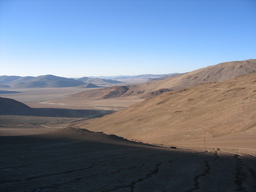
Aksai Chin: Chinese-
held Kashmir
2005.09.16 Tielong, China
|
|
Nothing grows at this altitude. We're up at 5,050 meters, taking lunch. Once again one of the truck's tires needs to be patched. We're pausing at one of the few outposts that support this road. There are a few stalls with auto-repair supplies, and a noodle-stall that dubs itself the "Xinjiang-Tibet Friendly Restaurant".
We've been making good time today, cruising across the Tibetan plateau. Today we crossed Aksai Chin. Despite that Aksai Chin is essentially a barren patch of rocks and hills, I was excited. I first heard of the region as an undergraduate, in a course about the history of modern India.
Aksai Chin is a chunk of north-eastern Kashmir. Which nation Kashmir belongs to is contested by four different countries. Pakistan and India are the obvious two, having twice gone to war over who owns the entire region. Additionally, China has occupied the northern areas of Kashmir for decades.
That slice of Kashmir is bounded by mountains and glaciers, difficult to reach from any direction. India actually didn't realize that China laid claim to any part of Kashmir until 1962, when troops from the Indian army inadvertently happened across the road we just came down. The two countries subsequently went to war to define their boundaries, India lost.
The fourth country with a potential claim to the region would be an independent state of Kashmir. When Britain quit India in 1947 they partitioned the territory into India, East Pakistan, and West Pakistan. The status of Kashmir was never resolved. The United Nations recommended a plebiscite, allowing the Kashmiris themselves to determine which country they would be a part of, or if they wanted to form an independent state. That, or any other measure towards resolution has yet to take place.
We spent last night in Hong Liu Tan, a small village with a large military base. There were a few shops and restaurants along the road, a satellite dish perched atop each place of business. We tuned in at the grotty restaurant where we spent the night. It was strange being able to watch any programs at all, let alone slick international broadcasts from the Middle East and the subcontinent.
I was surprised to see a Hindi-language infomercial. The production was identical to so many of the product-pitches shown in the States, scrolling text demanding, "Call Now!" coupled with toll-free telephone numbers. Actors portrayed the pantheon of Hindu gods. The item marketed was a crystal pyramid, blessed by priests at a certain temple. Priced at Rs. 1999, that would be nearly $45 U.S., not including shipping.
The last time I was in India there was one television station.
The scenery has been beautiful, since leaving the Aksai Chin region we've been passing through areas with more lakes. The mountains, which are always spectactular, continue on forever.